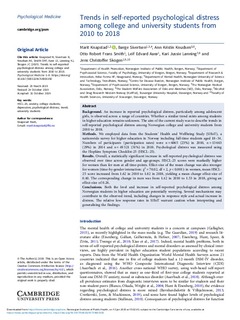| dc.contributor.author | Knapstad, Marit | |
| dc.contributor.author | Sivertsen, Børge | |
| dc.contributor.author | Knudsen, Ann Kristin | |
| dc.contributor.author | Smith, Otto Robert Frans | |
| dc.contributor.author | Aarø, Leif Edvard | |
| dc.contributor.author | Lønning, Kari Jussi | |
| dc.contributor.author | Skogen, Jens Christoffer | |
| dc.date.accessioned | 2020-01-28T12:42:30Z | |
| dc.date.available | 2020-01-28T12:42:30Z | |
| dc.date.created | 2020-01-13T16:17:11Z | |
| dc.date.issued | 2019 | |
| dc.identifier.citation | Psychological Medicine. 2019, . | nb_NO |
| dc.identifier.issn | 0033-2917 | |
| dc.identifier.uri | http://hdl.handle.net/11250/2638349 | |
| dc.description.abstract | Background
An increase in reported psychological distress, particularly among adolescent girls, is observed across a range of countries. Whether a similar trend exists among students in higher education remains unknown. The aim of the current study was to describe trends in self-reported psychological distress among Norwegian college and university students from 2010 to 2018.
Methods
We employed data from the Students' Health and Wellbeing Study (SHoT), a nationwide survey for higher education in Norway including full-time students aged 18–34. Numbers of participants (participation rates) were n = 6065 (23%) in 2010, n = 13 663 (29%) in 2014 and n = 49 321 (31%) in 2018. Psychological distress was measured using the Hopkins Symptom Checklist-25 (HSCL-25).
Results
Overall, a statistically significant increase in self-reported psychological distress was observed over time across gender and age-groups. HSCL-25 scores were markedly higher for women than for men at all time-points. Effect-size of the mean change was also stronger for women (time-by-gender interaction: χ2 = 70.02, df = 2, p < 0.001): in women, mean HSCL-25 score increased from 1.62 in 2010 to 1.82 in 2018, yielding a mean change effect-size of 0.40. The corresponding change in men was from 1.42 in 2010 to 1.53 in 2018, giving an effect-size of 0.26.
Conclusions
Both the level and increase in self-reported psychological distress among Norwegian students in higher education are potentially worrying. Several mechanisms may contribute to the observed trend, including changes in response style and actual increase in distress. The relative low response rates in SHoT warrant caution when interpreting and generalising the findings. | nb_NO |
| dc.language.iso | eng | nb_NO |
| dc.publisher | Cambridge University Press (CUP) | nb_NO |
| dc.rights | Navngivelse 4.0 Internasjonal | * |
| dc.rights.uri | http://creativecommons.org/licenses/by/4.0/deed.no | * |
| dc.title | Trends in self-reported psychological distress among college and university students from 2010 to 2018 | nb_NO |
| dc.type | Journal article | nb_NO |
| dc.type | Peer reviewed | nb_NO |
| dc.description.version | publishedVersion | nb_NO |
| dc.source.pagenumber | 9 | nb_NO |
| dc.source.journal | Psychological Medicine | nb_NO |
| dc.identifier.doi | 10.1017/S0033291719003350 | |
| dc.identifier.cristin | 1771782 | |
| dc.description.localcode | © The Author(s) 2019. This is an Open Access article, distributed under the terms of the Creative Commons Attribution licence (http:// creativecommons.org/licenses/by/4.0/), which permits unrestricted re-use, distribution, and reproduction in any medium, provided the original work is properly cited. | nb_NO |
| cristin.unitcode | 194,65,35,0 | |
| cristin.unitname | Institutt for psykisk helse | |
| cristin.ispublished | true | |
| cristin.fulltext | original | |
| cristin.qualitycode | 2 | |

